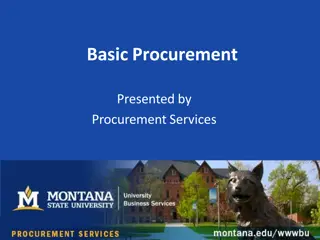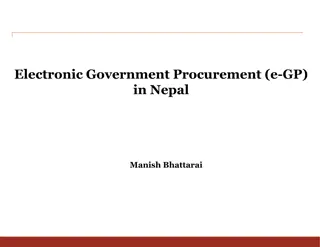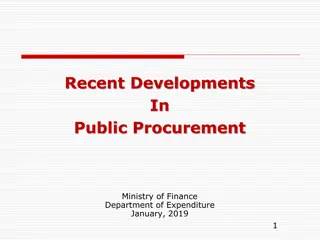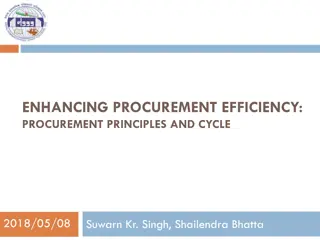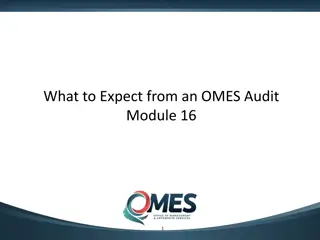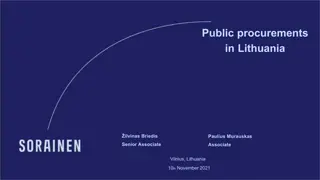Introducing OMES New Procurement Approach
Learn about the updated contract structure and acquisition planning methods introduced by OMES Central Purchasing. Understand the key differences and how agencies can efficiently provide procurement information.
Download Presentation

Please find below an Image/Link to download the presentation.
The content on the website is provided AS IS for your information and personal use only. It may not be sold, licensed, or shared on other websites without obtaining consent from the author.If you encounter any issues during the download, it is possible that the publisher has removed the file from their server.
You are allowed to download the files provided on this website for personal or commercial use, subject to the condition that they are used lawfully. All files are the property of their respective owners.
The content on the website is provided AS IS for your information and personal use only. It may not be sold, licensed, or shared on other websites without obtaining consent from the author.
E N D
Presentation Transcript
OMES New Template Revisited Introducing the Procurement Information Request and the Acquisition Planning Worksheet
Learner outcomes After the completion of this course, students will: Know what stayed the same and what changed. Understand the difference. Confidently complete the Acquisition Planning Worksheet.
New contract structure At the beginning of 2020, OMES Central Purchasing implemented a new contract structure. A webinar in December 2019 outlined the changes. Access the complete webinar presentation in Learn. Find a condensed version of the slides on the OMES website.
What is the same? The information an agency attaches to a requisition submitted to OMES Central Purchasing is primarily the same except one new ask, listed as No. 1 on the next slide.
What is different? Two big differences: 1. The one agency ask: An agency will need to compare its standard contract terms (formerly Section B of the RFP) to the State of Oklahoma General Terms. Remove from agency terms any provisions that are duplicates of provisions in the state general terms. For many agencies, this deduplication has reduced terms to a few pages. Note: An agency will go through this once. Afterward, the agencies should only revise their terms as required for specific acquisitions. OMES will not keep these terms on file. Attach a Microsoft Word list of contract terms the agency wishes to include in the procurement documents. Please confirm if no agency-specific terms are needed.
What is different, cont. Two big differences: 2. While the information is the same, the form in which the information is provided and its location in the procurement documents is not. The structure of documents is entirely different. The former RFP document with sections A, B, C and so forth is obsolete. Therefore, attaching the former RFP format to a requisition will delay issuance of the RFP. Refer to the webinar slides for a helpful guide between the former RFP sections and the sections of the new contract structure.
What an agency provides Central Purchasing An agency may use either of the two alternatives described in this presentation to provide the procurement information with a requisition. We recommend Alternative 1 for agencies new to the change. OMES is glad to schedule a planning meeting before an agency submits information, if needed. For agencies using Alternative 2, the online Acquisition Planning Worksheet may be a helpful guide. Regardless of the alternative, the procurement documents will be sent to the agency as usual, along with a suggested timeline for approval prior to issuance of the bid.
Questions 1. What was the one new ask from OMES? a) OMES asks you to compare the agency s specific terms to the state general terms.* b) OMES asks you to continue to use the old formatted terms. c) OMES asks you to not use the state general terms. 2. What was the same? a) The information formatted in the old RFP. b) The information an agency attaches to a requisition submitted to OMES Central Purchasing.* c) Nothing is new.
State contract structure: Alternative 1
Alternative 1 The Acquisition Planning Worksheet was created to ensure a smooth transition from the obsolete templates to the new structure. The worksheet is used to capture information an agency attaches to the ePro requisition. The contracting officer uses the worksheet and any accompanying documents and exhibits to build the procurement documents. Provide any list of exhibits as Exhibit titled [insert title]. Avoid numbering or alphabetizing exhibits because the resulting contract will not include all exhibits, and numbers/letters fall out of order. Some exhibits relate to bidder instructions only and others relate to contract performance after award. Likewise, renumbering exhibits at the time of award increases the likelihood an exhibit to the resulting contract will be missed.
Acquisition Planning Worksheet Clearly identify all information to correspond with the worksheet questions and include necessary exhibits. The information: May be listed within the Acquisition Planning Worksheet. or May be attached separately to the worksheet. The next slides describe typical information requested of an agency for attachment to an ePro requisition.
Acquisition Planning Worksheet A. Purpose: 1. Provide a few sentences to explain the need for the contract. Example: This contract is for SoonerCare Waitlist Management Services. [Add context if desired.]
Acquisition Planning Worksheet B. Contract term 1. What is the initial term of the contract? Examples: One year; through June 30, 2020. 2. When is the contract s effective date? Examples: The date of last signature; [a particular date]. 3. Number of options to renew, if any? 4. What is the time period of any optional renewals? Examples: One year; two years.
Acquisition Planning Worksheet C. Sensitive data List all categories of sensitive data the supplier will access, process, store or transmit. Examples: HIPPA. FERPA. CJIS. Federal tax information. Personally identifiable information of individuals. Critical infrastructure information. Information relating to relationship of IT devices, configurations, schematics, etc.
Acquisition Planning Worksheet D. Bid evaluation 1. Provide the criteria that will be used to score bids. Examples: Technical specifications. Price and cost. Financial responsibility. 2. Attach the evaluation tool, which should match the criteria listed above. 3. Identify the evaluation team members and provide contact information.
Questions 1. Using Alternative 1, how can you help OMES gather information for the Solicitation? a) Use the Acquisition Planning Worksheet. b) Fill out the worksheet and return to the contracting officer that requested it. c) All of the above.* 2. All information should be clearly identified to correspond with the worksheet questions and include necessary exhibits. a) Yes.* b) No. 3. What information is requested in the Acquisition Planning Worksheet? a) Purpose. b) Contract term. c) Sensitive data. d) Bid evaluation criteria. e) All of the above.*
Acquisition Planning Worksheet E. Bid information and requirements 1. Provide any desired historical usage, context, background information, etc. 2. Identify mandatory bid requirements. 3. Identify non-mandatory bid requirements. 4. Provide details of other information to be included in the bid, e.g., business references, value-added services, a required pricing structure, etc.
Contract performance obligations Provide a list of contract obligations to be performed after award of the contract. Examples: 1. Supplier shall submit a report annually by Aug. 1 showing number of customers served, by month. 2. Agency shall provide a list of Oklahoma lakes the supplier will test and the reported results.
State contract structure: Alternative 2
Alternative 2 Use Alternative 2 if an agency prefers to insert the relevant information in the procurement documents and attach them to the ePro requisition for review. Find templates on our webpage. View the December 2019 webinar to learn more about the referenced procurement documents. The submitted information should include: Bidder instructions including bid specifications and requirements. Attachment A, solicitation. Attachment C, agency-specific terms. Any required exhibits. However, list all bid-related information only in Section 8.1 of the bidder instructions.
Alternative 2, cont. Attachment B; State of Oklahoma General Terms and Attachment D, IT Terms (if applicable) need not be attached to the requisition before submission to Central Purchasing. As in the past, the agency provides all bid requirements, evaluation team list, and evaluation tool(s) or score tools.
Bid packet format The bidder instructions should state in which section particular information is required to be inserted so evaluators review uniformly formatted bids.
Bid packet format, cont. The required bid packet format contains the following sections: Section 1: Cover page Section 2: Required forms, certifications and disclosures Section 3: Bid portions requested to be held confidential Section 4: Bidder-requested exceptions to terms Section 5: Additional bidder terms Section 6: Existing terms between bidder and state (that apply to the resulting contract) Section 7: Executive summary Section 8: Response to specifications and requirements Section 9: Pricing Section 10: Offer of value-added products or services Section 11: Financial information Section 12: Business references Section 13: Additional company information
Questions 1. What is included in the bid information and requirements? a) Provide any desired historical usage, context, background information, etc. b) Identify mandatory bid requirements. c) Identify nonmandatory bid requirements. d) Provide details of other information to be included in the bid, e.g., business references, value-added services, a required pricing structure, etc. e) All of the above.* 2. When does the supplier provide contract performance obligations? a) Before award of contract b) After award of the contract.* 3. When should you use Alternative 2? a) You are a new CPO. b) You have no previous training. c) When an agency prefers to insert the relevant information in the procurement documents and attach them to the ePro requisition for review.*
Summary While the new structure is a huge step forward, it will be tweaked through continued use. OMES Central Purchasing is here to guide and help agencies through the process. Easily locate and download all new template documents and the Acquisition Planning Worksheet from the OMES website. As of July 1, the old RFP format will not be accepted for Central Purchasing contracts. Upcoming Brown Bag training will cover the supplier contract that results from the new structure.
OMES Central Purchasing Agency Acquisitions Team Richard Williams 405-522-1040 richard.williams@omes.ok.gov Stephanie Beshears stephanie.beshears@omes.ok.gov 405-522-1037 Sheri Diehm sheri.diehm@omes.ok.gov 405-365-1964 Darlene Saltzman* darlene.saltzman@omes.ok.gov 405-694-7016 Cinnamon Alexander* cinnamon.alexander@omes.ok.gov 405-365-2581 Jacob Short* jacob.short@omes.ok.gov 405-522-0437 Kimberley Coulter* kimberley.coulter@omes.ok.gov 405-328-3003 Rickey Thomas* rickey.thomas@omes.ok.gov 405-223-2693 *Acquisition approval workflow.
Requisition Submission In follow up to a recent CPO announcement, an agency is to submit an e-Pro requisition for all transactions, whether non-IT or IT, in these instances: when an agency requests the Central Purchasing Division to issue a solicitation or the first purchase order from a solicitation when an agency requests to issue the first purchase order from an agency-specific contract resulting from a solicitation when a change order is needed
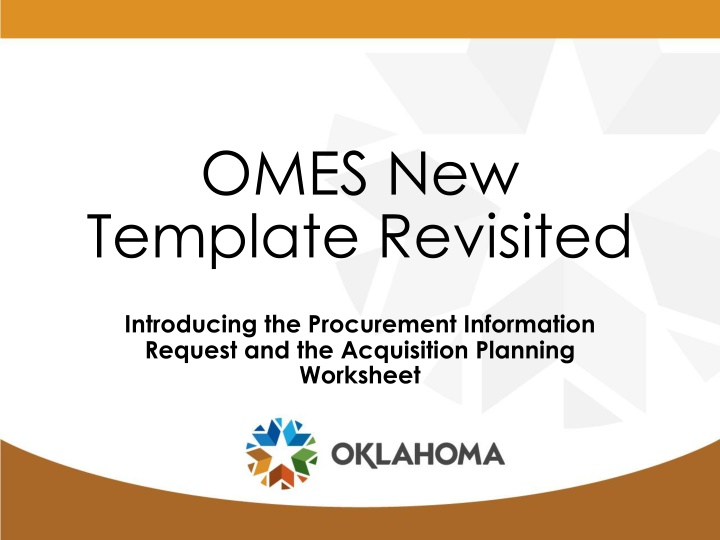

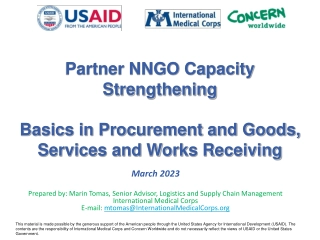




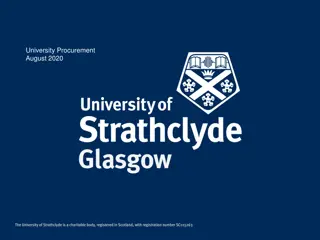
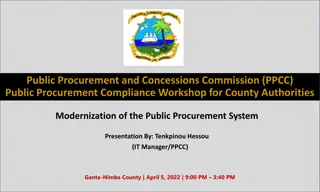
![Comprehensive Overview of Corruption Watch Submission on Public Procurement Bill [B18B-2023]](/thumb/138344/comprehensive-overview-of-corruption-watch-submission-on-public-procurement-bill-b18b-2023.jpg)
